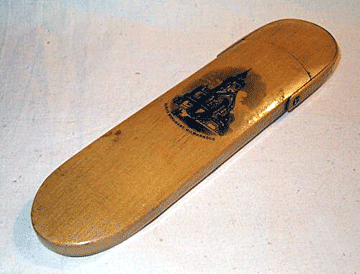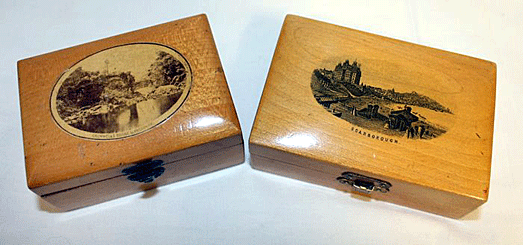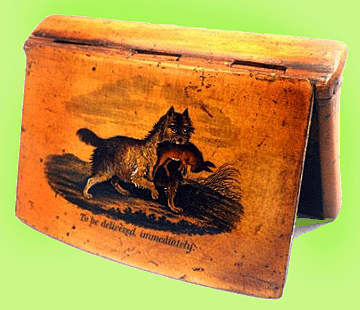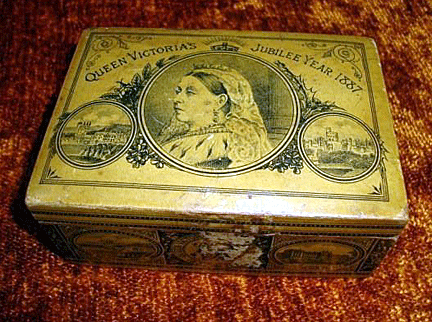 Have you often seen small boxes and other items made
of an ochre-colored wood decorated with scenes of tourist sites while
browsing through antique malls? Have you noticed the price of these items?
Whew! Stratospheric--especially for their small size. What youíve been
seeing is known as Mauchline(pronounced Mochílin) Ware, a form of souvenir
ware made by the Smith family of Mauchline, Ayrshire, now Strathclyde,
Scotland, and favored by affluent Victorians traveling abroad. Have you often seen small boxes and other items made
of an ochre-colored wood decorated with scenes of tourist sites while
browsing through antique malls? Have you noticed the price of these items?
Whew! Stratospheric--especially for their small size. What youíve been
seeing is known as Mauchline(pronounced Mochílin) Ware, a form of souvenir
ware made by the Smith family of Mauchline, Ayrshire, now Strathclyde,
Scotland, and favored by affluent Victorians traveling abroad.
Adorned with transfer ware scenes of landmarks, this
Scottish wooden ware dates from about 1880 to 1900. Though it was sold
throughout the United Kingdom, great quantities were also exported to many
parts of North America, Europe, South Africa, Australia and elsewhere.
Mauchline, located 11 miles inland from the Scottish
coastal resort of Ayr, was the center of the Mauchline Ware industry, which
at its peak in the 1860s, employed over 400 people in the manufacture of
small, but always beautifully made and invariably useful wooden souvenirs
and gift ware. If it werenít for the townís association with Robert
Burns, it would be difficult to find any present-day connection with the
industry. Similar products were also made in Lanark, but because of the
contribution its originators, W. & A. Smith of Mauchline, the vast
number of souvenirs produced in southwest Scotland from the early
19th-century to the 1930s is now referred to by the generic name of "Mauchline
Ware."
 Mauchline Ware developed partly by accident and partly
through necessity. Towards the end of the 18th century in the town of Alyth,
Perthshire(now Tayside), a man named John Sandy invented the "hidden
hinge" snuff box. He made the knuckles of the snuff boxís hinge form
alternately from those of the lid and the back of the box, with a metal rod
passing very precisely through the enter. This rod was a little shorter than
the box so as not to protrude through the ends, which he then plugged,
rendering the mechanism invisible. Mauchline Ware developed partly by accident and partly
through necessity. Towards the end of the 18th century in the town of Alyth,
Perthshire(now Tayside), a man named John Sandy invented the "hidden
hinge" snuff box. He made the knuckles of the snuff boxís hinge form
alternately from those of the lid and the back of the box, with a metal rod
passing very precisely through the enter. This rod was a little shorter than
the box so as not to protrude through the ends, which he then plugged,
rendering the mechanism invisible.
Since Sandy was bedridden for most of his life, Charles
Stiven, from Laurencekirk, took over the job of manufacturing and marketing
this invention, thus it became known as the Laurencekirk snuff box.
Eventually, the secret of the hidden hinge found its way to Cumnock, only a
few miles from Mauchline.
William Crawford began manufacturing the hidden hinge
snuffbox in Cumnock around 1810. Itís believed that he copied the hidden
hinge mechanism from a box brought to him for repair. Unable to keep the
secret to himself, it spread to at least 50 other Scottish snuff box
manufacturers in the early 1820s, most of them in Ayrshire. These included
William and Andrew Smith of Mauchline, whose family had formerly made razor
hones.
Craftsmen hand decorated early snuff boxes using either
colored paints or pen and ink. Then they gave the finished boxes numerous
coats of varnish, which enriched the final appearance as well a protected
the surface. Highly skilled artists created coaching scenes, field sports
and "drinking" topics, all favorite topics for snuff box
decoration.
 With so many manufacturers, snuff box production continued
at an all-time high, but the habit of taking snuff was on its way out.
Although they made mostly snuff boxes, manufacturers like W.& A. Smith
also produced other items, from postage stamp boxes to tea trays, all out of
wood. The first of the new products were tea caddies utilizing the hidden
hinge. In fact, they were so highly prized that when a female employee got
married she was given a Smith's Box Works tea caddy as a present. With so many manufacturers, snuff box production continued
at an all-time high, but the habit of taking snuff was on its way out.
Although they made mostly snuff boxes, manufacturers like W.& A. Smith
also produced other items, from postage stamp boxes to tea trays, all out of
wood. The first of the new products were tea caddies utilizing the hidden
hinge. In fact, they were so highly prized that when a female employee got
married she was given a Smith's Box Works tea caddy as a present.
Over the next century, the Smiths of Mauchline and their
competitors produced tens of thousands of articles in hundreds of styles and
in several different finishes. They generally used sycamore wood, which has
a very close grain and a pleasing color. The precise date of the first
transfer wares isnít known, but they companies manufactured them from the
early 1850s until 1933.
Woodworkers created more items with transfer decoration
than any other finish. These were true souvenir wares, since they decorated
each piece with a view associated with the place of purchase.
Skilled craftsman applied transfers to the finished
articles prior to coating them with several layers of slow drying copal
varnish. This process took from 6 to 12 weeks to complete, although it seems
that they must of developed an accelerated means of varnishing to cope with
the sheer scale of production. However, this lengthy and careful process of
manufacture accounted for the extreme durability of these products, many of
which have survived in near mint condition.
As with earlier hand-decorated snuff boxes, manufacturers
used sycamore wood, known as "plane" in Scotland, its pale color
making an excellent background for the black transfers.
While the majority of Mauchline Ware items were small,
thus warranting only a single transfer, it was by no means unusual for
craftsmen to apply six or more transfers to some of the larger pieces. Where
they applied more than one transfer, the views were always related to one
another, either by subject or geography.
 Views of Scotland dominated the transfer ware. "Burnsian"
views, by far, formed the largest single grouping and views associated with
Sir Walter Scott probably the second. In addition to virtually every town
and village, producers immortalized a great number of beauty spots, country
houses, churches, schools, ruins and even cottage hospitals in transfer
ware. Other views included seaside resorts and the inland spa towns of
Malvern, Cheltenham, Chester, Bath and Harrogate, which became increasingly
accessible to a growing number of people as a result of the rapidly
expanding rail network. The Isle of Wight was particularly popular, probably
due to Victoria's love of the place. And the popular south and east coast
resorts--Brighton, Eastbourne, Hastings, Margate and Scarborough--saw their
share. Views of Scotland dominated the transfer ware. "Burnsian"
views, by far, formed the largest single grouping and views associated with
Sir Walter Scott probably the second. In addition to virtually every town
and village, producers immortalized a great number of beauty spots, country
houses, churches, schools, ruins and even cottage hospitals in transfer
ware. Other views included seaside resorts and the inland spa towns of
Malvern, Cheltenham, Chester, Bath and Harrogate, which became increasingly
accessible to a growing number of people as a result of the rapidly
expanding rail network. The Isle of Wight was particularly popular, probably
due to Victoria's love of the place. And the popular south and east coast
resorts--Brighton, Eastbourne, Hastings, Margate and Scarborough--saw their
share.
Makers didnít forget the Channel Islands of Jersey and
Guernsey, as well as Stratford-upon -Avon, a close rival to London. They
even used some less obvious places, possibly because of an anticipated
tourist boom which failed to materialize.
It seems that, contrary to popular opinion, manufacturers
didnít update views to reflect changes of fashion, transport and indeed of
the towns, themselves. They introduced new transfer scenes as more and more
places were considered sufficiently commercial, but revised few, if any, of
the early views.
And although motorized transport became increasingly
common from the mid-1890s on, few scenes show any form of motorized
transport, but rather show the places, themselves. Indeed, railroads, as old as transfer ware itself, have
very little representation, with locomotives appearing in only a handful of
views. This suggests that companies made most of their transfer plates
before 1880, producing few after 1890.
Although Mauchline Ware production continued for another
40 years or so, its popularity began to decline, so the cost of producing a
large number of new plates would possibly have been prohibitive.
With the advent of photography in the latter part of the
19th century, many Mauchline Ware manufacturers turned to using
photographic images as an alternative to transfer printed views. Today,
collectors refer to these pieces as stick-on photographic ware. Although
manufacturers probably introduced photographic ware 20 to 30 years after the
first transfer-decorated items, collectors have found examples throughout
the range of production of Mauchline Ware. Tea caddies, snuff boxes, and
cigar boxes, which virtually ceased production by the time the first
photographic image was used in the mid-1860s, are obvious exceptions.
It's quite possible that the first use of photographic
images coincided with the establishment of the Caledonian Box Works in
Lanark in 1866, since Archibald Brown, its founder, had a keen interest in
photography. and made his own cameras. As a former employee of W.&A.
Smith, he couldn't compete successfully with them making the same wares.
Also, he was a friend of George Washington Wilson, perhaps Scotland's best
known photographer, and used his work extensively on his products.
Producers of Mauchline Ware employed photographic views
taken, in most cases, between the 1860s and the turn of the century. All
were of good quality, and from a historical point of view, are of far
greater interest than transfer views in that theyíre factual. W.& A.
Smith also produced photographic ware, but due to the overwhelming number of
their transfer ware items, they undoubtedly preferred the more delicate
transfer ware.
From the 1830s on, makers produced a steadily decreasing
number of snuff boxes while producing an increasing array of needlework,
stationery, domestic and cosmetic items as well as articles for personal
decoration and amusement. In addition, companies created an incredible range
of boxes in every conceivable size and shape and for limitless purposes.
Tea caddies and cigar boxes were the first of the new
lines, but by the middle of the 19th century, when the industry was at its
peak, virtually anything which could be made from wood and was comparatively
small and served a useful purpose, found its way into W.&A. Smithís
and othersí product lines.
Needlework itemsócontainers designed to hold or dispense
cottons, threads, silks, ribbons, wool, string, pins and needlesówere the
most popular and made in assorted shapes and sizes. In addition, makers
offered darning blocks and mushrooms, scissors cases, containers for
knitting pins, crochet hooks and bodkins and a remarkable range of novelty
thimble containers and tape measures. Among the most attractive sewing items
were the egg-shaped sewing "etuis," varying in size from bantam to
duck eggs. When opened, each revealed a hollow dowel with a removable top
fixed to the base of the egg and designed to hold needles. A small cotton or
thread spool was passed over the dowel and a thimble completed these
portable sewing companions.
A great many cotton, thread and ribbon manufacturersóJ
& P Coates, Chadwicks, Clarks Glenfield, Kerr and Medlockópurchased
Mauchline Ware containers for their products, their names clearly yet
discreetly displayed either inside the lid or on the base. Thus,
manufacturers transformed rather mundane accessories into attractive gifts.
 Stationery items ranged in size from large blotting
folders down to small bookmarks, including cylindrical rulers, some
incorporating a pencil and rubber eraser, while others were covered in a
mass of postal information. Rulers containing erasers and pencils became
instantly recognizable by a small knob at one end for the pencil and a much
larger one for the eraser at the other. Producers also turned out novelty
inkwells, pens, pencils, pencil boxes and letter openers, as well as many
designs of bookmarks including a patented combined bookmark and paper
cutter. Stationery items ranged in size from large blotting
folders down to small bookmarks, including cylindrical rulers, some
incorporating a pencil and rubber eraser, while others were covered in a
mass of postal information. Rulers containing erasers and pencils became
instantly recognizable by a small knob at one end for the pencil and a much
larger one for the eraser at the other. Producers also turned out novelty
inkwells, pens, pencils, pencil boxes and letter openers, as well as many
designs of bookmarks including a patented combined bookmark and paper
cutter.
Mackenzie and Meakle also produced boxes for postage
stamps of one, two, or three denominations, and offered circular single
denomination boxes. And they fitted the larger boxes with slopes to
facilitate easy stamp removal. Often they used a portrait of Sir Rowland
Hill, the founder of Englandís Penny Post, to decorate them.
Although wood isn't perhaps the most obvious material for
making jewelry, the more creative producers of Mauchline Ware made a number
of attractive earrings, brooches, and bracelets, the more expensive of
which, made around 1860, featured hand-painted segments.
Victorian ladies held their parasols with delicate
Mauchline Ware handles, and since gloves were an essential part of Victorian
dress, manufacturers like W.&A. Smith, also made glove stretchers.
Accessories for the Victorian ladyís dressing table
included ring trees and powder puff boxes as well as clothes and hair
brushes. One of the most unusual items was a flower holder. Containers for
cosmetics included boxes designed for face powder, rouge, cold cream and lip
cream.
The makers of Mauchline Ware didnít forget the home,
either, napkin rings being the most common item. They produced an assortment
in all sorts of finishes until the 1930s. Often they numbered the rings from
one to six, forming part of a boxed set. Occasionally, a collector will come
across a ring set numbered up to 12. The Victorian breakfast table may well
have been graced by a Mauchline Ware egg cruet, individual egg cups, and
several versions of egg timers, both free-standing and wall mounting.
Manufacturers produced candlesticks and vases, as well, in a variety of
finishes, as well as the more costly (and rare) versions produced from two
contrasting woods.
Since matches were essential to the Victorian home, makers
assembled a wide assortment of match containers. Some were no more than
novelty matchboxes serving no additional purpose, while others incorporated
a bone holder for an individual match. Often erroneously called "go to
beds," this type could serve as a candle providing light just long
enough to get into bed. Their true purpose, however, was to melt sealing wax
without burning the fingers.
Containers for money ranged from small ladies' purses to a
wide variety of money boxes. While producers often made them in the form of
chests and castles, the most unusual shape was that of a locomotive. They
also made trick money boxes, which can generally be found either in almost
mint condition, indicating that the child had despaired of extracting his or
her money and had given up trying, or in very poor condition, showing that
youthful patience had been exhausted and various implements had been used as
safe cracking tools.
Collectors have found at least three district versions of
eye glass cases. And with the popularity of photography, manufacturers
produced Mauchline Ware picture frames of all styles and sizes, as well as
photograph albums with wooden covers.
The Victorians loved to play card games and Mauchline Ware
manufacturers satisfied this craving with boxes for one, two or even more
packs of playing cards. Usually these boxes had three miniature cards glued
to the top to indicate their purpose. But they also made cribbage boards,
bezique markers, dice shakers and Chinese puzzles to satisfy the hunger of
Victorian entertainment.
And manufacturers didnít forget the children. Skipping
rope handles, tops, popguns and whistles all found in their way into
Mauchline Ware.
< Back to
Antiques Articles
Go to the next antiques article >
|
